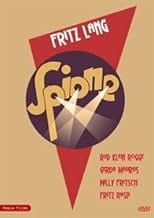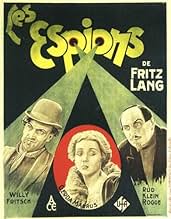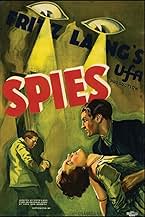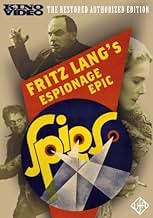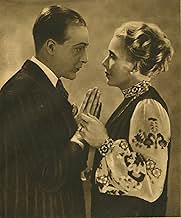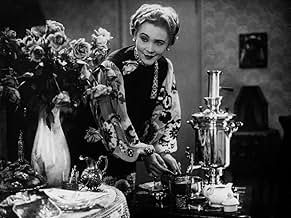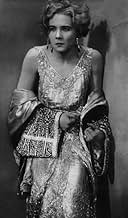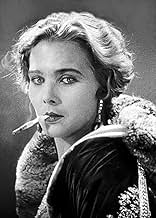AVALIAÇÃO DA IMDb
7,5/10
4,2 mil
SUA AVALIAÇÃO
O cérebro por detrás de uma operação de espionagem omnipresente descobre um romance perigoso entre uma rapariga russa ao seu serviço e um agente ousado do serviço secreto do governo.O cérebro por detrás de uma operação de espionagem omnipresente descobre um romance perigoso entre uma rapariga russa ao seu serviço e um agente ousado do serviço secreto do governo.O cérebro por detrás de uma operação de espionagem omnipresente descobre um romance perigoso entre uma rapariga russa ao seu serviço e um agente ousado do serviço secreto do governo.
- Direção
- Roteiristas
- Artistas
- Prêmios
- 1 indicação no total
Grete Berger
- Unconfirmed Role
- (não creditado)
Julius Falkenstein
- Hotel Manager
- (não creditado)
Heinrich Gotho
- Burton Jason's Other Assistant
- (não creditado)
Heinrich Gretler
- Spy in the Post Office scene
- (não creditado)
Gustl Gstettenbaur
- Boy Who Helps No. 326
- (não creditado)
Georg John
- Locomotive Engineer
- (não creditado)
Theodor Loos
- Handelsminister
- (não creditado)
Klaus Pohl
- Burton Jason's Assistant
- (não creditado)
Avaliações em destaque
Fritz Lang was one of the great silent film directors (His talkies are great as well) and this is his best silent film. Agents target the mysterious Haghi (Rudolf Klien-Rogge), a master criminal out to topple the banks of the world. The pursuit includes a seductive young female spy driving a Japanese business man to hari-kiri, assassinations, a chase and a showdown on a train (that collides in one heck of a sequence.) The film concludes with Haghi trapped on a stage where he is dressed as a clown (Why a powerful bank president moonlights as a third rate clown has always puzzled me.) Alfred Hitchcock openly cites this brillaint film as an influence. Also, there is a priceless glimpse of 1920's Germany here- the decadence of Berlin, where apartment dwellers turn their tiny flats into bars for extra cash. Even when the film plays in its complete 3 hour form, it's an exciting time at the movies.
"Spies" is much more entertaining than you would expect an old German silent movie to be, and at first, it's hard to say why. The character types are familiar from hundreds of other spy movies: a villain who is bent on world domination and has multiple secret identities, a beautiful blonde who works as a spy for the villain, a dashing enemy agent who falls in love with the female spy. The plot is fairly ludicrous, though it moves along briskly and provides for some great set-pieces, such as an exhilarating chase scene. But despite all the clichés found in "Spies," the movie still feels fresh and vital. You get drawn into the world of the film and accept the clichés, rather than becoming distracted by them.
I'm sure most of the credit for this has to go to the director, Fritz Lang. His films ("Metropolis," "M") often have a very dark world view, but the overall tone of "Spies" is escapist adventure-fantasy. It aims to provoke thrills, not shock or outrage. Lang creates some stunning visual compositions and proves to be a very detail-oriented directorhe delights in close-ups of spy gadgetry! His innovative use of montages, dramatic lighting, camera movement, and other techniques gives the film an interesting stylization.
I'm writing this review after watching the 90-minute American version of "Spies". But I had such a good time that I may have to seek out the 146-minute version!
I'm sure most of the credit for this has to go to the director, Fritz Lang. His films ("Metropolis," "M") often have a very dark world view, but the overall tone of "Spies" is escapist adventure-fantasy. It aims to provoke thrills, not shock or outrage. Lang creates some stunning visual compositions and proves to be a very detail-oriented directorhe delights in close-ups of spy gadgetry! His innovative use of montages, dramatic lighting, camera movement, and other techniques gives the film an interesting stylization.
I'm writing this review after watching the 90-minute American version of "Spies". But I had such a good time that I may have to seek out the 146-minute version!
Okay, the movie doesn't feature the secret agent with the famous number 007. But after I've seen this really entertaining movie , I wondered if Ian Fleming saw this movie before he created his legendary hero. It contains everything we already know from the James Bond movies:
- A strong and handsome hero with a secret identity number (this time 326) - A sinister and evil villain in a wheelchair (without a white cat, but with a striking resemblance to Lenin) - A secret headquarter for the villains - An attractive heroine, who falls immediately in love with the hero - exiting action-sequences and chases (featuring a crashing train and motorcycles) etc., etc. . Willy Fritsch is very good in the role of the hero (even though you wouldn't associate him with this genre when you saw his comedies) and Rudolf Klein Rogge (the mad scientist from Metropolis) is perfectly evil. The movie is fast-paced and very entertaining, despite its length of nearly three hours. Lang shows that he is correctly regarded as one of the best german directors of all time and that he is capable of succeeding in every genre, be it science-fiction, crime or even spy-adventures.
Fritz Lang, undeniably one of the greatest and most influential film-makers in all of cinema, is one of my favorites and, from his early work which remains, perhaps, his most important I only had a few of his surviving films still to catch up with. SPIONE was one of them and, now that I've watched it, I can confirm its stature as one of his very best, if relatively little-known.
The film is basically a follow-up to Lang's seminal two-part DR. MABUSE, THE GAMBLER (1922) and, indeed, it's Rudolph Klein-Rogge himself who originated the role of Mabuse who plays the evil crimelord here (called Haghi and who is made-up to resemble Lenin!). SPIONE follows much the same pattern of intrigue, thrills and action; however, the film's narrative structure is not straightforward but rather elliptical and, even though ostensibly dealing with the conflict which may arise were a treaty to fall into the wrong hands, several major plot points are left deliberately obscure (in fact, we never get to know what the treaty actually contains a precursor to Hitchcock's beloved "McGuffin", perhaps or what Haghi's intentions are, once he gets his hands on it!). In this respect, the social conscience so pronounced in the Mabuse diptych coming, as it did, on the heels of Germany's defeat in WWI is largely jettisoned here in favor of romance (between a female spy desired, and being blackmailed, by Haghi and the Secret Service agent who is the mastermind's nemesis), eroticism (the ensnaring of a central political figure by a vamp in Haghi's service) and technical dexterity (ensuring that SPIONE's considerable 2½-hour running-time goes by rapidly and without any longueurs, in my estimation at least, as opposed to the sluggish and rather static Mabuse). It is not inconceivable, therefore, to discern in Lang's fanciful melodrama the germ for all the spy thrillers which followed from Hitchcock to the James Bond extravaganzas and beyond.
As befits a master story-teller like Lang, particularly during this most creative phase of his career, SPIONE is virtually a catalogue of memorable scenes (interestingly enough, the supplementary photo gallery includes shots from sequences that are missing in the main feature!) chief among them a ghostly visitation, a ritual suicide, a train-wreck, a police raid on a bank and a stage performance by a clown; however as opposed to the DVD back-cover, which blatantly spells out its most clever twist in emulation of the film itself, I've refrained from giving too much away about them here
The film is basically a follow-up to Lang's seminal two-part DR. MABUSE, THE GAMBLER (1922) and, indeed, it's Rudolph Klein-Rogge himself who originated the role of Mabuse who plays the evil crimelord here (called Haghi and who is made-up to resemble Lenin!). SPIONE follows much the same pattern of intrigue, thrills and action; however, the film's narrative structure is not straightforward but rather elliptical and, even though ostensibly dealing with the conflict which may arise were a treaty to fall into the wrong hands, several major plot points are left deliberately obscure (in fact, we never get to know what the treaty actually contains a precursor to Hitchcock's beloved "McGuffin", perhaps or what Haghi's intentions are, once he gets his hands on it!). In this respect, the social conscience so pronounced in the Mabuse diptych coming, as it did, on the heels of Germany's defeat in WWI is largely jettisoned here in favor of romance (between a female spy desired, and being blackmailed, by Haghi and the Secret Service agent who is the mastermind's nemesis), eroticism (the ensnaring of a central political figure by a vamp in Haghi's service) and technical dexterity (ensuring that SPIONE's considerable 2½-hour running-time goes by rapidly and without any longueurs, in my estimation at least, as opposed to the sluggish and rather static Mabuse). It is not inconceivable, therefore, to discern in Lang's fanciful melodrama the germ for all the spy thrillers which followed from Hitchcock to the James Bond extravaganzas and beyond.
As befits a master story-teller like Lang, particularly during this most creative phase of his career, SPIONE is virtually a catalogue of memorable scenes (interestingly enough, the supplementary photo gallery includes shots from sequences that are missing in the main feature!) chief among them a ghostly visitation, a ritual suicide, a train-wreck, a police raid on a bank and a stage performance by a clown; however as opposed to the DVD back-cover, which blatantly spells out its most clever twist in emulation of the film itself, I've refrained from giving too much away about them here
In the space of the first one minute and 37 seconds, a safe is burgled, a diplomat is killed, two secret documents are stolen, and an intertitle demands "WHO IS BEHIND THIS?" We're off in the world of Fritz Lang's "Spies"
This film has everything that would later become spy film cliches: the ultra cool, ultra suave secret agent; the evil powerful genius, confined to a wheelchair, who dreams of world domination; his beautiful seductress, who falls for the secret agent. There are hidden microphones and disappearing ink and secret packages and bulletproof wallets. There's a motorcycle/car chase, and an in-tunnel train wreck to round out the action.
This film has everything that would later become spy film cliches: the ultra cool, ultra suave secret agent; the evil powerful genius, confined to a wheelchair, who dreams of world domination; his beautiful seductress, who falls for the secret agent. There are hidden microphones and disappearing ink and secret packages and bulletproof wallets. There's a motorcycle/car chase, and an in-tunnel train wreck to round out the action.
Você sabia?
- CuriosidadesUFA insisted on the film being made inexpensively, as Fritz Lang's previous film Metrópolis (1927) had brought the studio to near bankruptcy. Lang therefore chose to do most of the shots in narrow settings with lots of close-ups, as no big sets had to be built up for that way of filming. Fortunately "Spione" became a huge success.
- Erros de gravaçãoWhen Sonya and Franz (the chauffeur) are tied up and trying to escape, the hand cranking the camera is visible.
- ConexõesEdited into Fritz Lang, le cercle du destin - Les films allemands (2004)
Principais escolhas
Faça login para avaliar e ver a lista de recomendações personalizadas
- How long is Spies?Fornecido pela Alexa
Detalhes
- Tempo de duração2 horas 30 minutos
- Cor
- Mixagem de som
- Proporção
- 1.33 : 1
Contribua para esta página
Sugerir uma alteração ou adicionar conteúdo ausente



